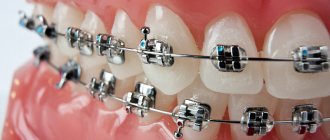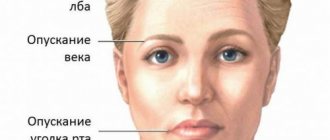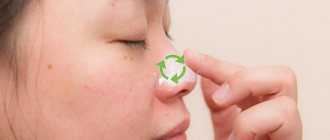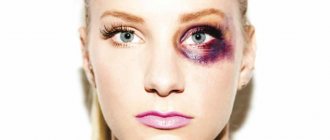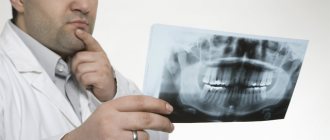Many people are familiar with the symptoms of muscle tension in the body. Sitting in front of a smartphone or monitor for too long - tight muscles in the back and neck hint that it would be nice to warm up. We decided to “take a walk” to the top floor or take our first jog of the season—the leg muscles immediately made themselves felt.
What if we tell you that right now, as you calmly read the article, the muscles in your face are also struggling with tension. They fight and can’t win. Surprised?
The main reasons why the oval of the face “floats”
Age-related changes
Skin aging is the most common cause of changes in facial contours. Most often this is expressed after 35 years. The production of collagen and elastin, which are responsible for the firmness and elasticity of the skin, begins to decrease.
Weight fluctuations
If extra pounds appear, the skin, accordingly, stretches. In case of sudden weight loss, it begins to sag because it does not have time to adapt to the new volumes.
Edema
The main causes of edema can be a sedentary lifestyle, poor diet, and bad habits such as alcohol and smoking. All this retains fluid in the body and swelling develops. Since water metabolism is disrupted, the contours of the face become rounded, and the skin becomes looser.
Improper skin care
If your skin is not cleansed and moisturized enough, it will begin to show signs of aging very early. Moreover, it is important to remember that the choice of skincare products should be based on a specific skin type. This will help achieve maximum effect from cosmetics and prevent your skin from aging early.
Incorrect posture
Constant slouching can lead to more than just spinal curvature. This also leads to the fact that the oval of the face becomes more drooping, the cheeks begin to sag, and the corners of the lips begin to droop down.
Exposure to direct sunlight
Ultraviolet radiation has a very adverse effect on the skin. Due to prolonged exposure to the sun, the skin ceases to produce enough collagen and this leads to rapid aging.
Why do muscles cramp in pregnant women?
Carrying a child leads to significant changes in the body. In particular, metabolism is rebuilt. As a result, many expectant mothers are faced with magnesium deficiency, which is why cramps appear.
Pregnant women's legs are subject to greater stress due to weight gain. Hence the involuntary muscle contractions that occur in the evenings and at night. They can also be triggered by varicose veins, which often accompany hormonal changes.
Pregnant women often complain about back pain. The lumbar spine is under constant tension, forced to bend under the pressure of the uterus, so such sensations are normal. Therefore, expectant mothers are recommended to lie on their side to relieve the load on the spine.
How to correct a swollen oval face
What can you do at home?
First, prevention is the best cure. The better the quality of your skin, the longer your facial contour will be clear and even. And you can improve the quality and density of your skin yourself with daily and proper care. Retinol is recommended as an anti-aging component - it affects both the dermis, triggering collagen formation processes, and the epidermis, stimulating cellular renewal processes. Currently, retinol is a very popular anti-aging component and for good reason - its effect is noticeable and pronounced, but it is important to remember about the peculiarities of its use, because it irritates the skin and if used incorrectly, complications can occur (it will be especially difficult to deal with vascular problems). Retinol is always applied at night; its use should always be accompanied by the use of SPF during the day.
Another important ingredient in skin tightening is vitamin C. Not only does it have vascular strengthening and brightening effects, but collagen formation processes also cannot take place without it! Even when taking collagen internally, you must make sure that you consume enough vitamin C, because otherwise all your efforts are in vain! By tightening the skin, vitamin C has a lifting effect and significantly improves the quality of the skin.
What can be done in a cosmetologist's office
Massages and microcurrents
They give a good effect and are also able to relieve the lymphatic system, preventing the formation of edema. It is important to follow the course and regularly.
Peelings
Stimulates cellular renewal processes. Cosmetologists often encounter patients’ fear that peelings thin the skin, but when done correctly, they, on the contrary, thicken and renew the tissue.
Mesotherapy and biorevitalization
An excellent way to influence the dermis - they stimulate collagen formation processes, saturate the skin with amino acids - the building material of proteins, and replenish the deficiency of hyaluronic acid. It is also important to follow the course of these procedures.
Fillers
A popular procedure, during which it is especially important to pay attention to the qualifications and working methods of the specialist. When tissues sag downwards, as a rule, the corrective method of choice will be not to work in the lower third of the face (not filling the nasolabial folds), but, first of all, to fill the deficit in the areas in which it has formed, that is, in the temporal and zygomatic areas. In any case, everything is individual and when installing fillers, it is extremely important to take into account the patient’s personal data, so look at the work of the cosmetologist you are contacting, read reviews, and ask what actions will be taken in case of failure. And, of course, for this procedure you can only consult a doctor!
Hardware techniques
Currently, the most popular type of oval restoration devices are ultrasonic face lift devices (non-surgical SMAS lifting). The principle is based on the fact that ultrasonic waves penetrate to a depth of 5 mm, causing targeted thermal contraction and tissue tightening, which leads to tightening of not only the skin, but also subcutaneous fat. As mentioned above, we are all individual and only a doctor can determine whether this technique is right for you after an individual consultation.
SMAS-lift
A surgical facelift can give an amazing result; in case of pronounced tissue prolapse, surgical intervention can help eliminate the problem, however, it is important to remember that here, too, a lot depends on the qualifications of the surgeon, so choose a specialist carefully. And let me remind you that the operation will not affect the quality of the skin in any way, so you should not wait for pronounced age-related changes to undergo surgery in the hope that it will solve all the problems at once.
Diagnostic methods
If the muscles cramp regularly and the person experiences severe pain, it is necessary to consult a doctor. You should also be concerned if this symptom does not have a clear cause (it is not associated with training or staying in an uncomfortable position for a long time).
A common reason why people put off seeing a doctor is not knowing who can help with the problem. It’s better to start with a therapist, and he will give you a referral to a specialist:
- neurologist;
- gastroenterologist;
- phlebologist;
- gynecologist;
- endocrinologist.
After the initial examination, collecting complaints and receiving test results, the doctor will tell you what additional diagnostic methods will be needed. If your stomach cramps, you will be referred for an ultrasound, your back for an X-ray, your neck or calf muscles for a Doppler ultrasound of the blood vessels.
Is it possible to correct gravitational ptosis with massage?
Facial massage is one of the main ways to maintain facial muscles in tone, which also helps improve skin condition, facial tone, and make the oval of the face and cheekbones clearer. During the procedure, muscles that are tense during the day and even during sleep relax. For example, one chewing muscle presses on the molars with a force of up to 90 kg. If this tension is not relieved, then habits such as involuntary clenching of the teeth, grinding them down, tics, headaches, and changes in the shape of the face may appear. When muscles are tense for a long time, that is, they are contracted, blood and lymph circulation in them decreases, metabolic products accumulate, inflammation and fat deposits may appear, this will lead to increased signs of facial aging. Facial massage is the only and natural way to get rid of such tension and its manifestations.
In addition, it has a lymphatic drainage effect, enhances the tone of the lymphatic vessels, lymph circulation in them, as a result of which the content of toxins and metabolic products in the tissues is significantly reduced, excess intercellular fluid (edema) is removed, that is, lymphatic drainage in the tissues is improved. Facial tone noticeably improves with a course of lymphatic drainage massage at any age. In order for the results of the massage to last for a long time, it is recommended to undergo a course of 10-14 procedures, once a week, and then a maintenance procedure once every 2 weeks.
Chewing muscles - anatomy
Before working with these muscles (and any others), you need to clearly understand their location on the face, shape, size, structure. Good visualization and concentration will improve the effectiveness of our exercises many times over! Therefore, a little anatomy is necessary:
On the left side of the picture, the “Masticator” is a superficial muscle that can be easily felt by placing your palms on it near the corners of the lower jaw and clenching your teeth.
The temporalis muscle is also a masticatory muscle, since its lower process is attached to the lower jaw (more precisely, to the coronoid process), so it also spasms from our habit of clenching our teeth and from stress.
There are also a couple of groups of deep masticatory muscles that for some reason are rarely talked about. Here they are:
1- Lateral masseter muscle, 3- medial masseter muscle.
And as you can see, they are deep - located right inside the skull, so it is quite difficult to relax them. What the tension of these muscles leads to, how it is reflected on the face - I’ll tell you now.
What types of anti-aging massage exist?
Sculptural
Sculptural massage deeply works the facial muscles, maintains their tone, which tightens the oval, eliminates the double chin, smoothes wrinkles in the forehead and eyes, evens out skin tone and removes puffiness. Recommended as prevention at the age of 25+ and ideal for 30+.
Buccal
During this type of massage, attention is paid to facial and chewing muscles, which improves blood microcirculation, strengthens facial muscles, restores facial skin, increases the elasticity and strength of muscle fibers.
Myofascial
One of the most powerful massage techniques. The effect is noticeable after the first massage - blood flow will increase, the movement of lymph will be activated, which removes toxins from the body, and muscle fibers will gain strength and elasticity.
Types of seizures
If involuntary contraction of muscle fibers is caused by overexcitation of the cortical part of the brain, such convulsions are classified as epileptic. Non-epileptic ones are provoked by diseases of the central nervous system, imbalance of nutrients, and unfavorable external conditions.
Also, involuntary muscle contractions can be classified according to their nature:
- tonic – long-term, turning into a state of tension;
- myoclonic – short;
- clonic - jerky, cyclically repeating and alternating with relaxation.
Based on localization, these phenomena are divided into generalized and local. The former cover a significant part of the body (arms, legs, face, neck, side, torso, and sometimes extend to the respiratory tract). The latter occur in separate areas (for example, only in the back or only in the buttock).
Treatment of nervous tics
Nervous tics are treated by a neurologist. In case of primary tic, a psychotherapist can help. Primary tics in children usually go away with age. To relieve symptoms and speed up recovery, it is recommended:
- normalization and adherence to the daily routine. It is necessary to get up, eat and go to bed at approximately the same time;
- proper and balanced nutrition;
- active lifestyle, sports, walks in the fresh air;
- eliminating excessive mental stress;
- reduction of psycho-emotional stress. Normalization of relationships in the family, and for the child also at school, is of great importance.
If tic manifestations are severe, the doctor may prescribe medication. For secondary tics, treatment is primarily aimed at combating the underlying disease that caused the tic. In most cases, with successful treatment of the underlying disease, the tic disappears.
Massage and reflexology are also used to treat tics.
Prevention
The best prevention of involuntary muscle contractions is moderate physical activity. Regular exercise helps keep your muscles under control. The tissues will not suffer from physical inactivity or sudden overload. This is equally beneficial for both men and women at any age.
A set of exercises to prevent cramps always includes stretching. It is useful to do it before bed so that unpleasant symptoms do not occur at rest.
Since muscles often cramp due to hypovitaminosis and lack of microelements, it is important to eat a balanced diet. If you cannot get them in sufficient quantities from food, you should additionally take vitamins B and E, as well as magnesium, calcium and potassium supplements. It is also important to drink enough fluids, because similar discomfort occurs due to dehydration.
Drug treatment for muscle spasms
There is no universal remedy for muscle spasms of the head and neck. If the pain is episodic, taking painkillers in combination with supplementation with vitamins and minerals may be enough. If we are talking about chronic involuntary muscle contractions, the patient may be prescribed antiepileptic drugs, muscle relaxants, antidepressants, and antipsychotics. The doctor may also recommend medications to strengthen blood vessels and normalize blood circulation.
All patients with muscle pain are advised to ensure sufficient physical activity, avoid alcohol consumption, reduce stress levels, eat nutritiously and get enough sleep.
Causes of pathology
The main cause of hyperkinesis is dysfunction of the cerebral motor system. This disorder can be caused by various factors:
- degenerative processes in the central nervous system that are hereditary in nature;
- conditions associated with perinatal trauma;
- suffered traumatic brain injuries;
- brain tumors;
- various toxic lesions - alcoholism, CO2 poisoning;
- previous neuroinfections – meningitis, encephalitis;
- cerebrovascular accidents;
- endocrine diseases;
- psychogenic factors – neuroses, psychoses, anxiety disorders.
Hyperkinesis in some cases occurs as a side effect when taking psychostimulants or antipsychotics.
You need to massage your facial skin along the lines of lymph movement:
- from the point between the eyebrows up to the hairline;
- from the same point to the temples along the brow ridges;
- also from this point along the back of the nose to the tip and down the wings;
- from the inner corner of the eye to the outer, then from the outer to the inner;
- from the sinuses to the temples;
- from a point above the upper lip to the middle of each ear;
- from the point under the lower lip to the earlobes;
- from the earlobes down the neck to the collarbones;
- in front from the collarbones along the larynx up to the chin.
It is necessary to make movements in these directions to tighten the skin and prevent the formation of wrinkles.


